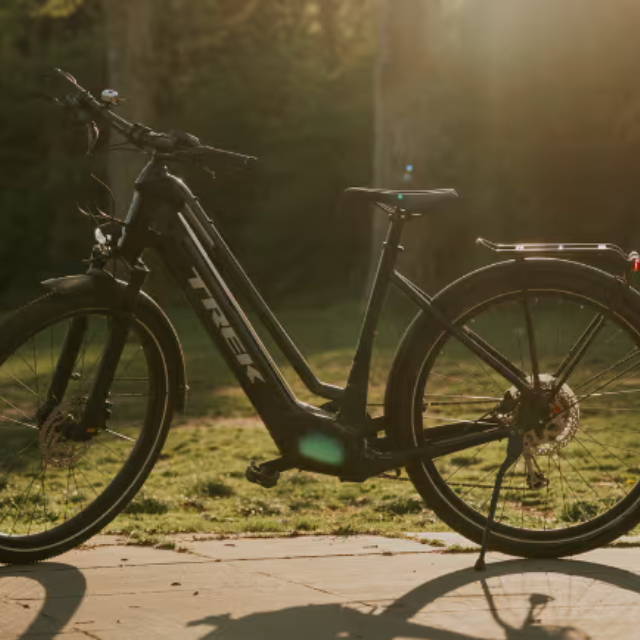Yes, most 1¼” rack mounts can carry two standard e-Bikes without surpassing the maximum weight and bike capacity. However, check the rack’s specific weight limit and compare it to the weight of the e-Bike or used electric bike you expect to transport.
Load Up: 2” vs 1¼” E-Bike Rack Mounts
Written by: Rémy Rossi | March 7, 2025 | Time to read 7 min
Before you decide on a rack for your vehicle, get all the most important deets in this do-it-yourself electric bike guide comparing 2” and 1¼” hitch mounts.

More about the Author: Remy Rossi
Rémy Rossi is a bike writer, mechanic, and educator who got his start in community-based bike shops and co-ops. With a decade in the industry, he still wrenches on bikes when he can and plays bike polo on a fixie.

Hitch Receiver Sizes
Hitch bike racks fit into the hitch receiver installed at the rear of your vehicle. The two most common sizes are 1¼” and 2”. I’ll walk you through a more comprehensive comparison of the two sizes so you know exactly what you’re getting into.
2” Hitch Receivers

1¼” Hitch Receivers
You may see terms like Class I, II, or III thrown around when investigating hitch racks. That’s because hitch receivers on vehicles are grouped into classes based on their weight and towing capacity. 1¼” are either Class I or II while heavier-duty 2” hitch receivers are rated Class III and can hold significantly more extra weight. Check your vehicle’s hitch rating to ensure you’re not surpassing the maximum load capacity.

2-Inch vs. 1¼-Inch E-Bike Rack Mounts: Key Differences
Weight capacity

Stability during transport
The last thing drivers want is to see their hitch mount bike rack bounce up and down through the rear window. 2” rack mounts and their heavier-duty design are generally less prone to swaying or wobbling during transit. That said, the possibility of unsettling sway exists on any size of hitch attachment.
Certain bike rack mounts come with a tightening mechanism that expands inside the receiver. If not, users can purchase an anti-rattle hitch tightener, which is a U-shaped shackle that clamps and secures the rack to the receiver. An anti-rattle pin and hitch lock are great additions and e-Bike accessories to any receiver hitch.
🤝 Why you can trust us for buying an e-Bike?
- Great prices: Get your next e-Bike for up to 60% off retail prices, in new or like-new conditions.
- Quality Guaranteed: Every e-Bike is rigorously certified by a team of professional mechanics, and comes with a 1-year warranty.
- Delivered to Your Door: Delivered to your home within a week. Change your mind? Return it thanks to our 14-day return policy.
Installation and use
How to Choose the Right E-Bike Rack Mount
Hitch receiver size
The e-Bike hitch rack you pick needs to be compatible with your vehicle’s hitch receiver. Some bike racks are universally compatible with both 1¼” and 2” hitch receivers while others are designed for a specific size. Before you start your search, figure out your vehicle’s hitch receiver measurements.
Number of bikes

If you're only ever going to transport two bikes, 1¼” is probably fine, but 2-inch receivers give you the ability to upgrade to a 3- or 4-bike carrier. Some 2-bike hitch racks can accommodate an extender rack to bump carrying capacity to three or four bikes, but that setup is reserved for heavy-duty 2” rack mounts.
3- and 4-bike hitch racks are only sold in 2” hitch receiver versions. In general, a 2” hitch bike rack is a good option for transporting heavy bikes or large types of bikes like e-Bikes, electric mountain bikes, and fat-tire bikes.
Many hitch racks are platform bike racks— also called tray-style bike racks— where the bikes are secured on top of a platform via the bike wheels instead of being attached via the bike frame. This is a sturdy design that assists with loading bikes and allows for lifting the bikes with ease— there is often a convenient tilt-away feature for easy trunk access. Being able to take bikes on and off easily simplifies getting to the trails quickly and charging e-Bikes after a ride.
Expected use and terrain
If you’re transporting bikes with a car, odds are you’re in for an adventure. A heavy-duty 2” rack mount provides a bit more stability over bumpy terrain and off-road routes, preventing bikes from swaying and bouncing all over the place. The larger size is also a nice choice for longer road trips and extra peace of mind throughout the journey. For short trips over smooth roads, a 1¼” rack mount does the job just fine.
Budget
Lighter-weight bike racks are generally cheaper than heavy-duty racks rated for high payloads. 1¼” rack mounts can be a more affordable option if they work with your type of vehicle or lightweight e-Bikes. Some bike racks can be ordered in either hitch size with little or no price difference between the two choices. The cash you save from Upway’s hottest e-Bike deals this month can go toward purchasing a high-quality bike rack!

Frequently Asked Questions
Can a 1¼-inch rack mount carry two e-Bikes?
How much weight can a 1¼-inch hitch hold?
Many of the most popular 1¼-inch hitch racks can support a total of 70-160 lbs. If you need to transport more than two e-Bikes or have especially heavy e-Bikes, a 2” hitch rack will be necessary.
Is there a significant difference in stability between 2-inch and 1¼-inch mounts?
While there isn’t a huge difference between the two hitch sizes, 2” mounts are generally sturdier and less prone to swaying.
Key Takeaways
- 2” Hitch Mounts Handle More Weight and Provide Stability: Best for SUVs and trucks, 2” mounts support heavier e-Bikes and multiple-bike setups with less swaying.
- 1¼” Hitch Mounts Are Lighter and Easier to Use: Ideal for sedans and crossovers, they work well for one or two e-Bikes but have a lower weight capacity.
- Vehicle Compatibility and Usage: Consider hitch size, number of bikes, terrain, and budget when selecting the right e-Bike rack mount.


